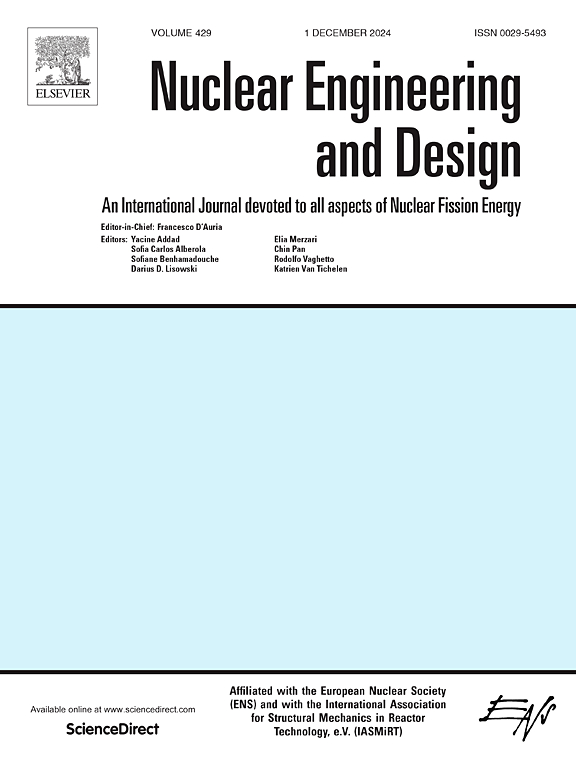Optimization of loading quantity of minor actinides for elimination of boric acid and burnable absorbers from PWRs
IF 2.1
3区 工程技术
Q1 NUCLEAR SCIENCE & TECHNOLOGY
引用次数: 0
Abstract
The use of burnable absorbers for reactivity control in PWRs comes with added costs, potential residual reactivity and power peaking effects, and demands careful consideration of depletion time and reactivity feedback. Again, boric acid in the coolant further complicates reactor operation by requiring water chemistry adjustments and presenting issues such as corrosion, tritium production (from boron) and a less negative moderator temperature coefficient (MTC). This study investigates the feasibility of using minor actinides (MAs) to eliminate both burnable absorbers and boric acid from PWRs, thereby improving safety and reducing long-term radiotoxicity. Six different models were analyzed – three featuring integral burnable absorbers (IBAs) with MA-based fuels, and three without IBAs. The reference was a VVER-1000 fuel assembly with 1000 ppm boric acid in the coolant. MAs were introduced either as inner or outer coatings on the fuel or as homogeneous mixtures within the fuel matrix. Simulations using OpenMC over a 600 EFPD burnup period showed that all studied cases could suppress excess reactivity equivalently to conventional poisons, though with varying MA requirements. MA addition also led to significant transmutation and improved MTC, albeit with some degradation in fuel cycle performance. Homogeneously loaded cases (3A and 3B) proved to be the most effective in controlling reactivity, achieving higher transmutation rates (TRs), improved reactivity feedback, and reduced penalties in cycle length and discharge burnup. Notably, Case 3B fully compensated for both gadolinia and boric acid, achieved the highest TR of 25.82 %/y for all MAs combined, and exhibited the most negative MTC.
压水堆中微量锕系元素去除硼酸和可燃吸收剂的负荷优化
在压水堆中使用可燃吸收剂进行反应性控制会增加成本、潜在的剩余反应性和功率峰值效应,并且需要仔细考虑耗尽时间和反应性反馈。同样,冷却剂中的硼酸需要对水化学进行调整,并出现腐蚀、氚生成(来自硼)和负慢化剂温度系数(MTC)较低等问题,从而进一步使反应堆运行复杂化。本研究探讨了使用微量锕系元素(MAs)去除pwr中可燃吸收剂和硼酸的可行性,从而提高安全性并降低长期放射性毒性。研究人员分析了六种不同的模型,其中三种采用基于ma燃料的整体式可燃吸收器(),三种不采用。参考是在冷却剂中含有1000ppm硼酸的VVER-1000燃料组件。MAs要么作为燃料的内部或外部涂层引入,要么作为燃料基体内的均匀混合物引入。使用OpenMC进行的600 EFPD燃燃期模拟表明,尽管MA要求不同,但所有研究案例都可以抑制与常规毒物相当的过量反应性。MA的加入也导致了显著的嬗变和MTC的改善,尽管燃料循环性能有所下降。均匀加载的情况下(3A和3B)被证明是最有效的控制反应性,实现更高的转化率(TRs),改善反应性反馈,减少循环长度和放电燃耗的惩罚。值得注意的是,病例3B完全补偿了钆酸和硼酸,所有ma组合的TR最高,为25.82% /年,并且表现出最多的负MTC。
本文章由计算机程序翻译,如有差异,请以英文原文为准。
求助全文
约1分钟内获得全文
求助全文
来源期刊

Nuclear Engineering and Design
工程技术-核科学技术
CiteScore
3.40
自引率
11.80%
发文量
377
审稿时长
5 months
期刊介绍:
Nuclear Engineering and Design covers the wide range of disciplines involved in the engineering, design, safety and construction of nuclear fission reactors. The Editors welcome papers both on applied and innovative aspects and developments in nuclear science and technology.
Fundamentals of Reactor Design include:
• Thermal-Hydraulics and Core Physics
• Safety Analysis, Risk Assessment (PSA)
• Structural and Mechanical Engineering
• Materials Science
• Fuel Behavior and Design
• Structural Plant Design
• Engineering of Reactor Components
• Experiments
Aspects beyond fundamentals of Reactor Design covered:
• Accident Mitigation Measures
• Reactor Control Systems
• Licensing Issues
• Safeguard Engineering
• Economy of Plants
• Reprocessing / Waste Disposal
• Applications of Nuclear Energy
• Maintenance
• Decommissioning
Papers on new reactor ideas and developments (Generation IV reactors) such as inherently safe modular HTRs, High Performance LWRs/HWRs and LMFBs/GFR will be considered; Actinide Burners, Accelerator Driven Systems, Energy Amplifiers and other special designs of power and research reactors and their applications are also encouraged.
 求助内容:
求助内容: 应助结果提醒方式:
应助结果提醒方式:


